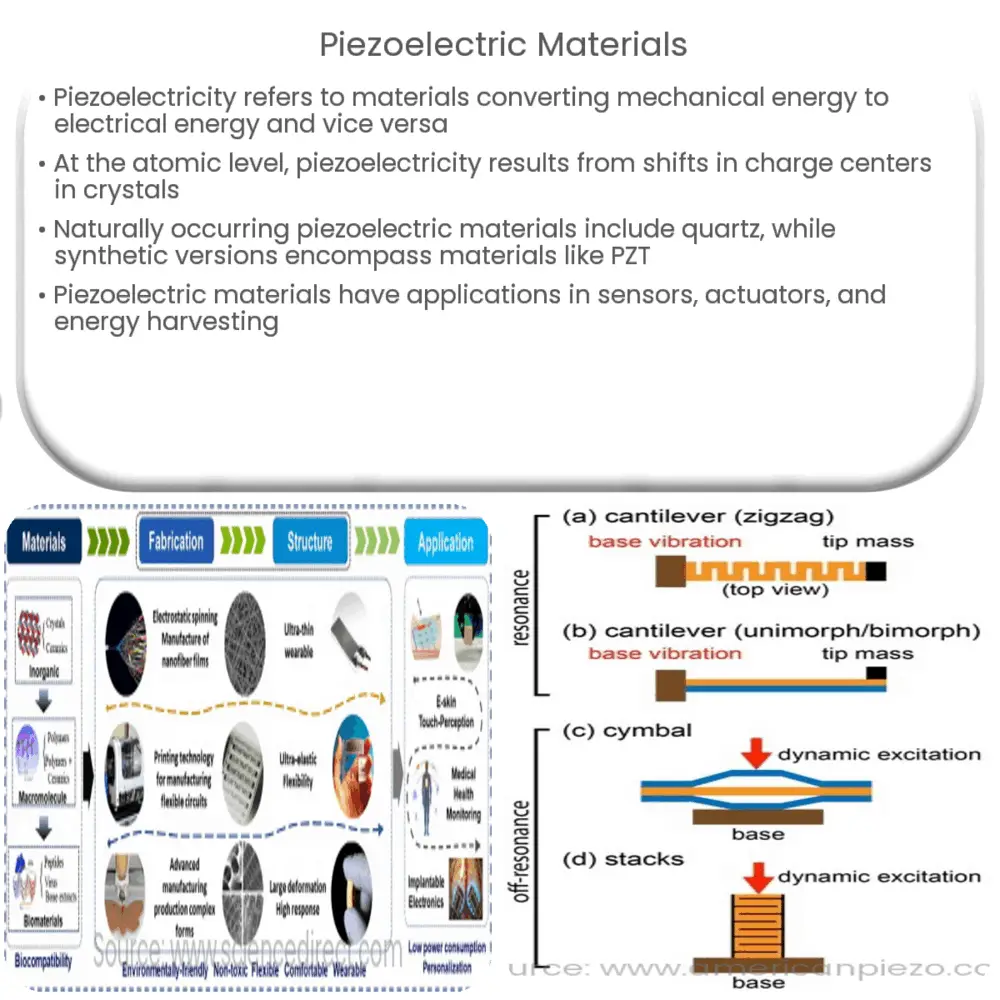Explore the world of piezoelectric materials, their unique properties, various applications, and future potential in technology.

Introduction to Piezoelectric Materials
Piezoelectricity, a fascinating phenomenon of material science, comes from the Greek word ‘piezein’, which means ‘to press’. The materials exhibiting this effect, termed ‘Piezoelectric Materials’, convert mechanical energy into electrical energy and vice versa.
The Principle of Piezoelectricity
At the atomic level, the principle of piezoelectricity can be described as a shift in the positive and negative charge centers within the crystal structure, resulting in an electric dipole moment. When an external mechanical force is applied, it alters the dipole moment, inducing a voltage across the material.
Types of Piezoelectric Materials
- Natural Piezoelectric Materials: These are naturally occurring materials like quartz, Rochelle salt, and topaz, possessing piezoelectric properties.
- Synthetic Piezoelectric Materials: These include manufactured materials such as ceramics like barium titanate and lead zirconate titanate (PZT), polymers like polyvinylidene fluoride (PVDF), and others like gallium orthophosphate.
Understanding Piezoelectric Effect
In piezoelectric materials, when a mechanical stress is applied, it displaces the charged particles, creating an electric field. This is known as the ‘direct piezoelectric effect’. Conversely, when an electric field is applied, it causes a strain within the material structure, resulting in a change of shape or size. This is referred to as the ‘inverse piezoelectric effect’.
Piezoelectric Material Structure
Piezoelectric materials, in general, have a unique crystal structure. Each unit cell in the crystalline structure comprises a positive ion and a negative ion. Under normal conditions, the center of positive charges aligns with the center of negative charges. But under the influence of an external force, these centers get displaced causing an electric polarization. This polarization directly correlates with the mechanical strain applied, giving rise to the piezoelectric effect.
Applications of Piezoelectric Materials
- Sensors: Due to the direct piezoelectric effect, these materials find their application in various types of sensors, including pressure sensors, accelerometers, and vibration sensors.
- Actuators: Utilizing the inverse piezoelectric effect, piezoelectric materials can also act as actuators to control mechanical displacement in micromechanical systems.
- Energy Harvesting: Piezoelectric materials can convert vibrational energy into electrical energy, providing a renewable source of energy.
Other Applications
In addition to the mentioned applications, piezoelectric materials are used extensively in the field of ultrasonics. For instance, ultrasound imaging in medical diagnostics, ultrasonic cleaning, and non-destructive testing all utilize the properties of these materials. They also play a crucial role in various consumer electronics like lighters, buzzers, and quartz watches.
Piezoelectric Materials in Future Technologies
The significance of piezoelectric materials extends into emerging fields such as nanotechnology and IoT (Internet of Things). Nanoscale piezoelectric materials can potentially be used in the construction of nano-electromechanical systems (NEMS). They are also being explored for their potential applications in wearable technology, where the human body’s movements could be harnessed to power wearable devices.
Challenges and Research
Despite their broad applications, piezoelectric materials face certain challenges such as high manufacturing cost, temperature sensitivity, and material toxicity (like lead in PZT). Ongoing research aims to mitigate these issues by developing new materials with enhanced properties and reduced environmental impact. Advances in material science like the discovery of organic and bio-inspired piezoelectric materials signal promising future developments in this field.
Conclusion
To conclude, piezoelectric materials represent an intriguing blend of physics, chemistry, and material science, exhibiting unique properties that allow conversion of mechanical energy into electrical energy and vice versa. Their wide range of applications, from sensors and actuators to energy harvesting, speaks volumes about their importance in our daily lives and future technologies. The challenges that currently exist prompt further research into discovering more efficient and environmentally friendly piezoelectric materials. Indeed, with the ongoing technological advancements, the future of piezoelectric materials looks brighter than ever, opening new avenues for innovation and development.

